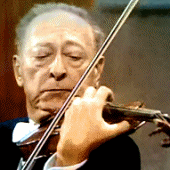| Vilnius |
![]()
Visiting Jascha Heifetz's birth place has been an emotional experience for me, in more than one sense.
Apart from the obvious reasons, I was also visiting my own forefathers place of birth, my grandmother's and my great grandparents'. My previous attempts to visit Vilna[!] during the communist era came to naught; I was refused entry. Today Vilnius, and Lithuania, very different places, a free country and a very hospitable one to its many foreign visitors.
Following the trail of Heifetz's early childhood, I visited the streets and alleys where the young Heifetz used to walk, usually with his father, to and from violin lessons, to and from the schul. Time and events had certainly took their toll on the city and the once culturally prosperous and prestigious "Jerusalem of Litta [Lithuania]", as it was nicknamed by its Jewish inhabitants, had suffered its affronts. Out of over 100 synagogues active at the turn of the 20th century for example, there is but one now standing. The former Great Synagogue was destroyed during WWII. Interestingly, when it was built, laws forbidding synagogues to be higher than any church in the city were still in force. Thus, the Great Synagogue, so locals tell me, was built to the same height as the nearby church, but included three underground levels, such that from the inside it truly looked tall... Nowadays there is a kinder garden built on its perimeter, facing the nearby home of the famous Vilna Gaon Elijahu rabbi.
Heifetz's birth house(s) (the bracketed plural derives from the new dispute over the actual location of the houses - there are two...), proved to be an experience in its own right. There is, for a few years now, a rather hot academic debate which I personally find fascinating, ever since new evidence has surfaced in 2004 - too late to be included in Galina Kopytova's excellent book on Heifetz's Russian Years. Maestro Sondeckis, the conductor of the Lithuanian Philharmonic Orchestra kindly supplied us information about the new findings, as did Messrs. Jurjius Greismanas and Geinrich Agranovski of the Vilna Gaon Jewish Community Museum. Mr. Agronovsky is the historian who first discovered the new documents which possibly point to Heifetz's new address (see the Debate page).
Maestro Sondeckis was also on hand to kindly give us a tour of the Philharmonic Hall, detailing the place where Heifetz, the young prodigy boy, had returned to play in 1912. His knowledge about Heifetz's early years in Vilnius came in handy during the Philharmonic tour where, some 100 years previously the young boy had returned from St. Petersburg to give his first comeback concert. Being his first appearance in his native city after an absence of over two years, his performance was eagerly awaited by the entire local community. Amusingly, Maestro Sondeckis tells us, little Jascha was nowhere to be found when his turn to play came. His parents became increasingly alarmed the closer his turn to play approached, and started to frantically search for the boy. Finally they found him at the side artists' door, in the street, blissfully playing football with other children, adorned in his concert stage tails. Rubin Heifetz quickly broke up the game, dragged Jascha inside and proceeded to clean his dusty clothes the best he could. Unflustered, Jascha walked on stage just in time and proceeded to give a memorable performance of the Mendelssohn concerto which echoed in the newspapers reviews the following day. Ah, the young days of a virtuoso in the making...
Maestro Saulius Sondeckis is by all accounts and evidence a rather extraordinary personality. He enjoys the distinction of his parents being immortalized at the Yad Vashem Memorial Hall in Jerusalem, as the Righteous of the Nations. During WWII they had hid and rescued Jewish families from the occupying Nazi forces, putting their own life at great risk. Maestro Sondeckis was among the strongest opponents to the demolition plans of the Heifetz house, fought and eventually succeeded in preserving it intact. He struggle made New York Times news and Schonberg was interested in his work. Maestro Sondeckis tells us that when the photo of the house was shown to Heifetz, the violinist is said to have recognized it. He was also instrumental in raising and preserving the plaque on the building formerly known as the Imperial Conservatory of Music, where little Heifetz had studied the violin for five years in Vilnius. The plaque was funded, among other sources, by contributions from Heifetz's late son, Robert, who had visited Vilnius in the 90s.
►
Vilnius► Vilnius celebrates Heifetz: Press and Centenary






